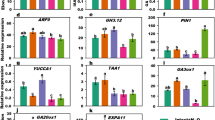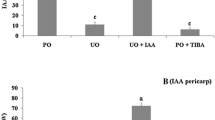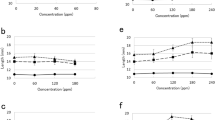Abstract
Removal of stamens, or even of only the anthers, at an early stage of corolla development, before the start of main anthocyanin production, inhibited both growth and pigmentation of attached corollas of Petunia. When only one or two stamens were removed from one side, the inhibition was restricted to the corolla side adjacent to the detached stamens. Application of gibberellic acid (GA3) substituted for the stamens in its effect on both growth and pigmentation. In detached corollas, isolated at the early-green stage and grown in vitro in sucrose medium, GA3 promoted growth and was essential for anthocyanin synthesis. A marked enhancement of anthocyanin production was observed 48 h before the increase in corolla growth rate. Corollas detached at later stages were able to continue their growth and pigmentation in sucrose without GA3. When Paclobutrazol (β-[(4-chlorophenyl)-ethyl]-α(1,1-dimethylethyl)-H-1,2,4-triazol-1-ethanol), an inhibitor of gibberellin biosynthesis, was added to the growth medium of in-vitro-grown corollas, pigmentation was inhibited but there was no effect on corolla growth. Low levels of GA3 counteracted the Paclobutrazol effect on pigmentation but did not affect growth. The above results indicate that the effect of GA3 (and probably that of the stamens) on corolla growth is independent of its effect on pigmentation. Gibberellic acid and paclobutrazol had no effect on [14C]sucrose uptake by in-vitro-grown corollas. The activity of phenylalanine ammonialyase was correlated with the effect of stamens and GA3 on pigmentation in corollas grown in vivo and in vitro.
Similar content being viewed by others
Abbreviations
- GA:
-
gibberellin
- GA3 :
-
gibberellic acid
- PAC:
-
Paclobutrazol
- PAL:
-
phenylalanine ammonia-lyase
References
Bala, R., Rao, I.V.R., Mohan Ram, H.Y. (1985) Influence of stamens, gibberellic acid and sucrose on corolla growth in Gladiolus. J. Plant Physiol. 122, 87–92
Biran, I., Halevy, A.H. (1974) Effect of short-term heat and shade treatments on petal colour of ‘Baccara’ roses. Physiol. Plant. 31, 180–185
Bradford, M.M. (1976) A rapid and sensitive method for the quantitation of microgram quantities of protein utilizing the principle of protein-dye binding. Anal. Biochem. 72, 248–254
Christina, K., Cheng, C., Marsh, H.V. (1968) Gibberellic acid promoted lignification and phenylalanine ammonia-lyase activity in dwarf pea (Pisum sativum). Plant Physiol. 43, 1755–1759
Cordts, J.M., Scorza, R., Bell, R.L. (1987) Effect of carbohydrates and nitrogen on the development of anthocyanins of a red leaf peach (Prunus persica (L.). Batsch) in vitro. Plant Cell Tiss. Org. Cult. 9, 103–110
Halevy, A.H. (1987) Assimilate allocation and flower development. In: Manipulation of flowering, pp. 363–378, Atherton, J.G., ed. Butterworths, London
Harborne, J.B., (1976) Function of flavonoids in plants. In: Chemistry and biochemistry of plant pigments, pp. 736–778, Goodwin, T.W., ed. Academic Press, London
Heinzmann, U., Seitz, U. (1977) Synthesis of phenylalanine ammonia-lyase in anthocyanin-containing and anthocyanin-free callus cells of Daucus carota L. Planta 135, 63–67
Kinet, J.M., Sachs, R.M., Bernier, G. (1985) The physiology of flowering, vol. III. CRC Press, Boca Raton, Fla., USA
Klein, A.O., Hagen, C.W. (1961) Anthocyanin production in detached petals of Impatiens balsamina. Plant Physiol. 36, 1–9
Koning, R.E. (1985) Gaillardia. In: Handbook of flowering, vol. 5, pp. 117–126, Halevy, A.H., ed. CRC Press, Boca Raton, Fla., USA
Mancinelli, A.L., Yang, C.P.H., Lindquist, P., Anderson, O.R., Rabino, I. (1975) Photocontrol of anthocyanin synthesis. III. The action of streptomycin. Plant Physiol 55, 251–257
Mohan Ram, H.Y., Rao, I.V.R. (1984) Physiology of flower bud growth and opening. Proc. Indian Acad. Sci. 93, 353–374
Nester, J.E., Zeevaart, J.A.D. (1988) Flower development in normal tomato and a gibberellin-deficient (GA-2) mutant. Am. J. Bot. 75, 45–55
Raab, M.M., Koning, R.E. (1987) Changes in responsiveness to ethylene and gibberellin during corolla expansion of Ipomoea nil. J. Plant Growth Regul. 6, 121–131
Weiss, D., Schonfeld, M., Halevy, A.H. (1988) Phytosynthetic activity in the Petunia corolla. Plant Physiol 87, 660–670
Wong, E. (1976) Biosynthesis of flavanoids. In: Chemistry and biochemistry of plant pigments. pp. 464–526, Goodwin, T.W., ed. Academic Press, London
Zieslin, N., Biran, I., Halevy, A.H. (1974) The effect of growth regulators on the growth and pigmentation of ‘Baccara’ rose flowers. Plant Cell Physiol. 15, 341–349
Zucker, M. (1969) Induction of phenylalanine ammonia-lyase in Xanthium leaf disks. Photosynthetic requirement and effect of day length. Plant Physiol. 44, 912–922
Author information
Authors and Affiliations
Rights and permissions
About this article
Cite this article
Weiss, D., Halevy, A.H. Stamens and gibberellin in the regulation of corolla pigmentation and growth in Petunia hybrida . Planta 179, 89–96 (1989). https://doi.org/10.1007/BF00395775
Received:
Accepted:
Issue Date:
DOI: https://doi.org/10.1007/BF00395775




